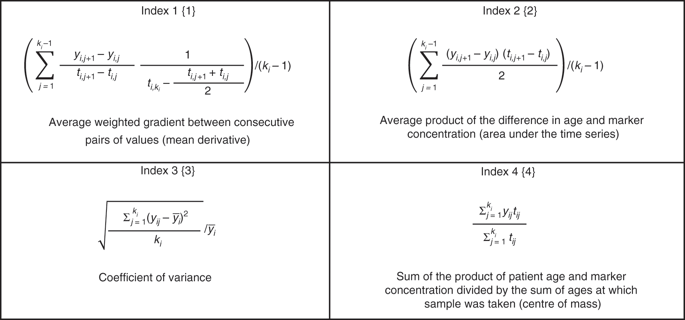当前位置:
X-MOL 学术
›
Br. J. Cancer
›
论文详情
Our official English website, www.x-mol.net, welcomes your feedback! (Note: you will need to create a separate account there.)
Improved early detection of ovarian cancer using longitudinal multimarker models.
British Journal of Cancer ( IF 8.8 ) Pub Date : 2020-01-15 , DOI: 10.1038/s41416-019-0718-9 Harry J Whitwell 1 , Jenny Worthington 1 , Oleg Blyuss 1, 2, 3 , Aleksandra Gentry-Maharaj 4 , Andy Ryan 4 , Richard Gunu 1 , Jatinderpal Kalsi 1, 4 , Usha Menon 4 , Ian Jacobs 1, 5 , Alexey Zaikin 1, 2, 6, 7 , John F Timms 1
British Journal of Cancer ( IF 8.8 ) Pub Date : 2020-01-15 , DOI: 10.1038/s41416-019-0718-9 Harry J Whitwell 1 , Jenny Worthington 1 , Oleg Blyuss 1, 2, 3 , Aleksandra Gentry-Maharaj 4 , Andy Ryan 4 , Richard Gunu 1 , Jatinderpal Kalsi 1, 4 , Usha Menon 4 , Ian Jacobs 1, 5 , Alexey Zaikin 1, 2, 6, 7 , John F Timms 1
Affiliation

|
BACKGROUND
Ovarian cancer has a poor survival rate due to late diagnosis and improved methods are needed for its early detection. Our primary objective was to identify and incorporate additional biomarkers into longitudinal models to improve on the performance of CA125 as a first-line screening test for ovarian cancer.
METHODS
This case-control study nested within UKCTOCS used 490 serial serum samples from 49 women later diagnosed with ovarian cancer and 31 control women who were cancer-free. Proteomics-based biomarker discovery was carried out using pooled samples and selected candidates, including those from the literature, assayed in all serial samples. Multimarker longitudinal models were derived and tested against CA125 for early detection of ovarian cancer.
RESULTS
The best performing models, incorporating CA125, HE4, CHI3L1, PEBP4 and/or AGR2, provided 85.7% sensitivity at 95.4% specificity up to 1 year before diagnosis, significantly improving on CA125 alone. For Type II cases (mostly high-grade serous), models achieved 95.5% sensitivity at 95.4% specificity. Predictive values were elevated earlier than CA125, showing the potential of models to improve lead time.
CONCLUSIONS
We have identified candidate biomarkers and tested longitudinal multimarker models that significantly improve on CA125 for early detection of ovarian cancer. These models now warrant independent validation.
中文翻译:

使用纵向多标志物模型改进卵巢癌的早期检测。
背景技术卵巢癌由于诊断较晚,存活率低,需要改进方法进行早期检测。我们的主要目标是识别额外的生物标志物并将其纳入纵向模型,以提高 CA125 作为卵巢癌一线筛查试验的性能。方法 这项嵌套在 UKCTOCS 中的病例对照研究使用了来自 49 名后来被诊断患有卵巢癌的女性和 31 名无癌症的对照女性的 490 份系列血清样本。基于蛋白质组学的生物标志物发现是使用合并的样本和选定的候选者(包括文献中的候选者)在所有系列样本中进行分析的。衍生多标记纵向模型并针对 CA125 进行测试,以早期检测卵巢癌。结果 性能最好的模型,包含 CA125、HE4、CHI3L1、PEBP4 和/或 AGR2 在诊断前 1 年以 95.4% 的特异性提供 85.7% 的敏感性,显着改善了单独的 CA125。对于 II 型病例(主要是高级浆液性),模型以 95.4% 的特异性达到 95.5% 的敏感性。预测值比 CA125 更早地提高,表明模型具有改善交货时间的潜力。结论 我们已经确定了候选生物标志物并测试了纵向多标志物模型,这些模型显着改善了 CA125 用于卵巢癌的早期检测。这些模型现在需要独立验证。显示模型在改进交货时间方面的潜力。结论 我们已经确定了候选生物标志物并测试了纵向多标志物模型,这些模型显着改善了 CA125 用于卵巢癌的早期检测。这些模型现在需要独立验证。显示模型在改进交货时间方面的潜力。结论 我们已经确定了候选生物标志物并测试了纵向多标志物模型,这些模型显着改善了 CA125 用于卵巢癌的早期检测。这些模型现在需要独立验证。
更新日期:2020-01-15
中文翻译:

使用纵向多标志物模型改进卵巢癌的早期检测。
背景技术卵巢癌由于诊断较晚,存活率低,需要改进方法进行早期检测。我们的主要目标是识别额外的生物标志物并将其纳入纵向模型,以提高 CA125 作为卵巢癌一线筛查试验的性能。方法 这项嵌套在 UKCTOCS 中的病例对照研究使用了来自 49 名后来被诊断患有卵巢癌的女性和 31 名无癌症的对照女性的 490 份系列血清样本。基于蛋白质组学的生物标志物发现是使用合并的样本和选定的候选者(包括文献中的候选者)在所有系列样本中进行分析的。衍生多标记纵向模型并针对 CA125 进行测试,以早期检测卵巢癌。结果 性能最好的模型,包含 CA125、HE4、CHI3L1、PEBP4 和/或 AGR2 在诊断前 1 年以 95.4% 的特异性提供 85.7% 的敏感性,显着改善了单独的 CA125。对于 II 型病例(主要是高级浆液性),模型以 95.4% 的特异性达到 95.5% 的敏感性。预测值比 CA125 更早地提高,表明模型具有改善交货时间的潜力。结论 我们已经确定了候选生物标志物并测试了纵向多标志物模型,这些模型显着改善了 CA125 用于卵巢癌的早期检测。这些模型现在需要独立验证。显示模型在改进交货时间方面的潜力。结论 我们已经确定了候选生物标志物并测试了纵向多标志物模型,这些模型显着改善了 CA125 用于卵巢癌的早期检测。这些模型现在需要独立验证。显示模型在改进交货时间方面的潜力。结论 我们已经确定了候选生物标志物并测试了纵向多标志物模型,这些模型显着改善了 CA125 用于卵巢癌的早期检测。这些模型现在需要独立验证。



























 京公网安备 11010802027423号
京公网安备 11010802027423号